Recently I visited Kiev and “accidentally” called at St. Cyril’s Church on 12, Oleny Teligi Street. Although I was entering the church with interest, I did not expect to see anything special there. To tell the truth, I had never been particularly interested in the issue, which was not right as I later on understood. I believe, once you familiarize yourselves with this article you will grasp the reason, dear readers.
Well, let us start with generally known information about St. Cyril’s Church. After St. Sophia’s Cathedral it is the second largest Christian temple in Kiev, which has remained in its own walls since the time of Ancient Rus. The church was founded in the 12th century and, luckily, has been preserved in its original form till nowadays. Its interior has remained almost intact since those times with 800 square metres of 12-century frescoes depicting various scenes on the walls. Some of the images are truly unique and not found in any other ancient sacral monuments in the world. That is, such frescoes are only in Kiev and only in St. Cyril’s Church.
In 1965 the church became a branch of St. Sophia of Kiev National Historical and Cultural Reserve, and in 1994 it was included in the list of UNESCO World Heritage Sites. At that, since 1929 till nowadays St. Cyril’s Church has had the status of a museum. (
Restoration works carried out in the 17-18th centuries added Ukrainian baroque features to St. Cyril’s Church exterior, but its basis and general layout has remained unchanged since the 12th century. In olden times the church represented a typical Byzantine cross-domed, single-dome sacral building oriented from the west to the east.
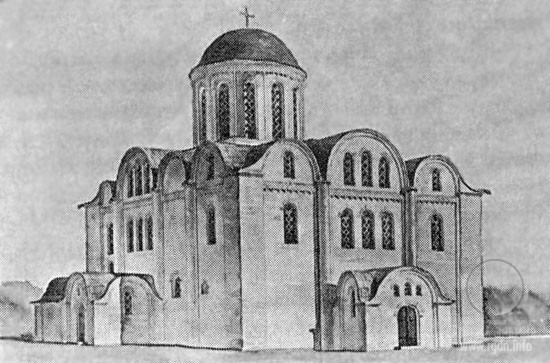
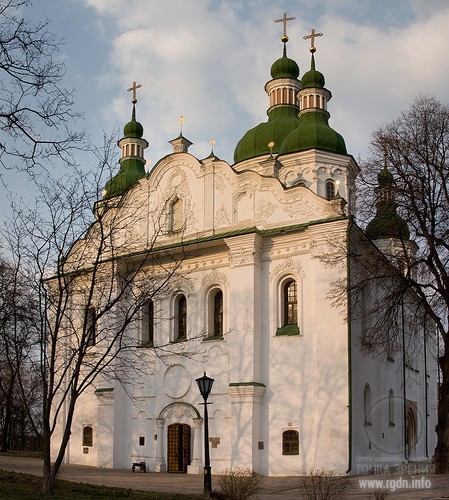
1139 is considered to be the year of the church establishment. To understand how the knowledge we describe in this article turned out to be on the walls of St. Cyril’s Church nearly 900 years ago, let us reproduce the chronology of some events of that time. So:
According to the above chronology, the knowledge which is reflected in wall paintings of St. Cyril’s Church and became the basis of the Orthodox religion in Rus were brought to the society exactly in the times of Agapit of Pechersk. For an inquisitive mind it is easy to find relevant information, compare facts and grasp why Agapit is called Russian Bodhisattva, why pilgrims from all over the world reached for him, and why in the 11-12th centuries a mass surge of identical spiritual knowledge was observed across the planet, on different continents and in different cultures. Yet, this is a topic for a separate article, whereas now we are discussing another thing.
Sensei of Shambala – Book IV by Anastasia Novykh explains the reason of the simultaneous surge of spiritual knowledge in various cultures all over the globe:
… from time to time human society is attended by Bodhisattvas of Shambala who mostly deal with restoration of the lost spiritual knowledge and true history of development of human civilizations, which has either been lost by people in time, or hidden from the majority of people, or modified by other people for their greedy and power-seeking purposes. Bodhisattvas also give additional information about the world, depending on the level of scientific achievements of civilization. That is, they take a neutral position relative to the human society and as far as possible give pure information to people, without a touch of fantasy, dirt of ages or various human ambitions. Whether to accept such information or not is a personal choice of every human in the society who has become lucky to possess the knowledge of Shambala, which is dreamt of by the powers that be of this world. Correspondingly, it’s up to a given person or humanity as a whole whether they will resist the Evil while possessing such information and conduct real Good deeds in this world, or just please their own vanity with this knowledge. Let me emphasize once again: people who follow the spiritual way are themselves to resist Evil and Archons within the human society. By the way, since ancient times such people have been called Arhats.
I am unable to describe every square metre of wall paintings in the church, and I don’t even have such a goal. Let me just describe what has touched me to the depth of my heart and become another incontrovertible evidence of the trueness of the knowledge resumed nowadays owing to the AllatRa and other books by Anastasia Novykh. Everyone who has read the AllatRa book and still has any doubts can come to St. Cyril’s Church and get convinced with his or her own eyes that the aforesaid Knowledge was a foundation on which the Orthodox faith was being formed almost 900 years ago.
Well, let us enter this ancient, truly unique building and try to figure out why people who lived almost a millennium ago erected it and what they endeavoured to communicate to future generations.
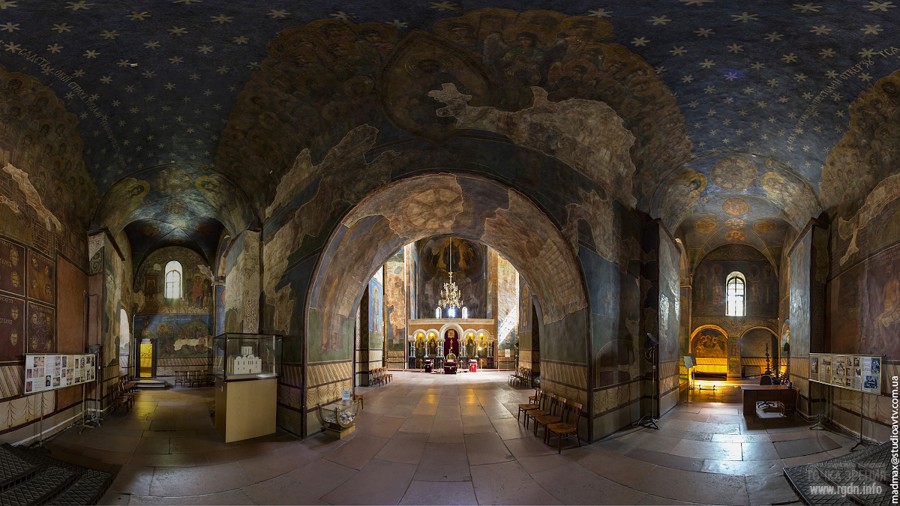
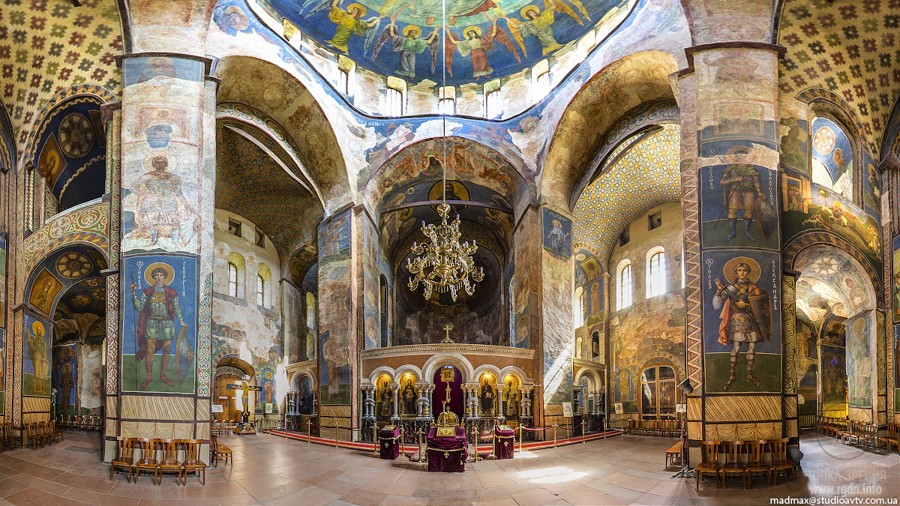
A blissful feeling cloaks one from the first minutes of one’s stay in the church. Time becomes slower, thoughts move to the background, and a sensation of sincere interest to the environment captures one’s attention. Having walked a little from the entrance towards the central iconostasis and lifted up our eyes, we see a marvellous cupola with the image of Our LadyOrans in the radiance of divine light beams. This light is as if Living; it fascinates and fills one with warmth and quiet heartfelt joy.
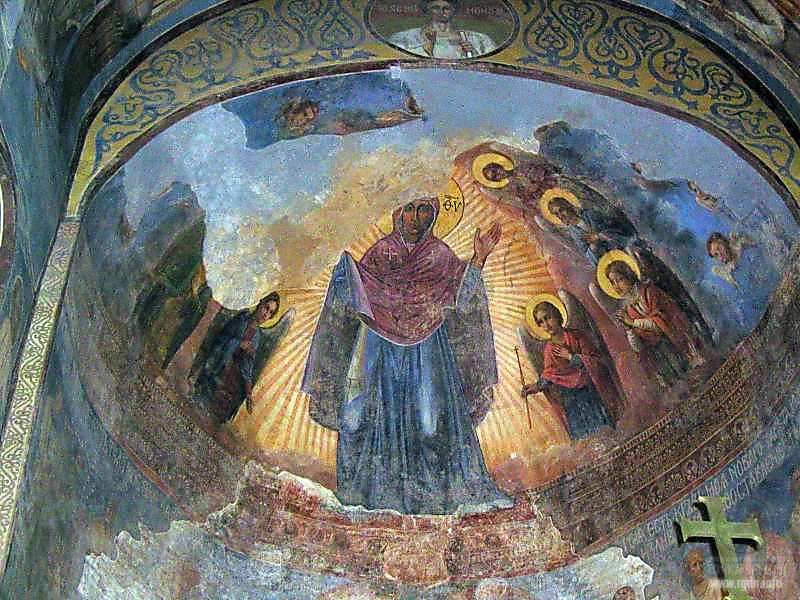
On the wall to the right of the altar there is a Christmas scene depicted. About thirty percent of the painting has been restored. At that, the restored part mostly includes fragments of the background and just a little piece of the main scene. Here is what a visitor sees when approaching the wall…
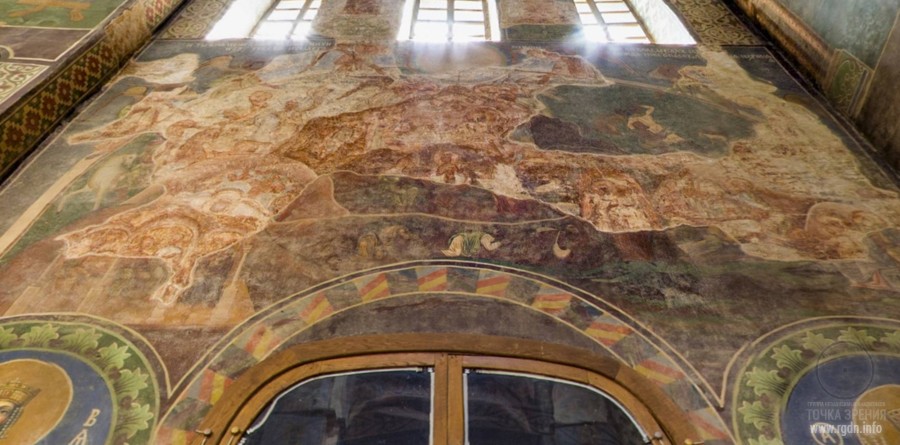
Please, notice the condition of the restored painting in the central part of the church, near the iconostasis. It looks like there was no restoration at all… Why are exactly these parts of the church not properly restored? As a matter of fact, it’s the wall to the right of the central cupola, one of the main spots for the knowledge communication. What do you see? Almost nothing! The same picture is observed on the left wall of the church, too. At the same time, 90 to 100% of images of princes and governors, as well as scenes that bear no knowledge have been restored all over the church. Here are some of them for comparison:
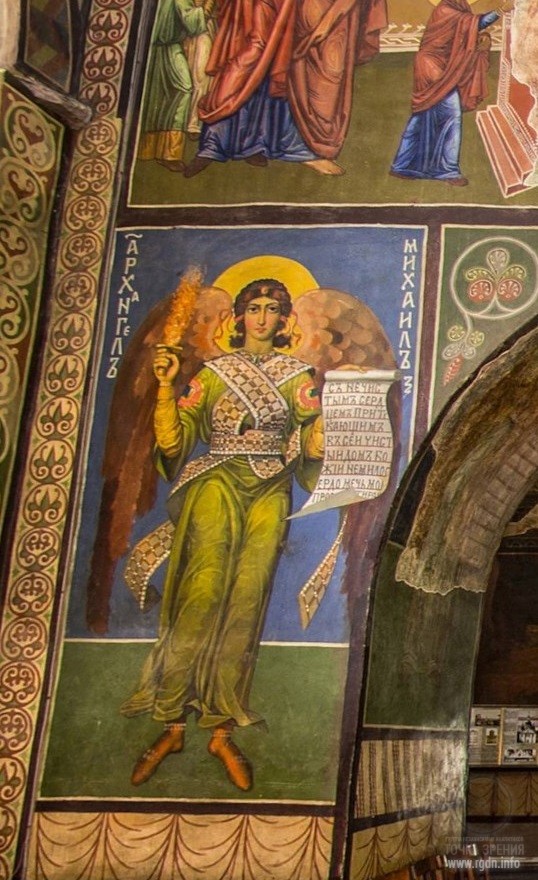
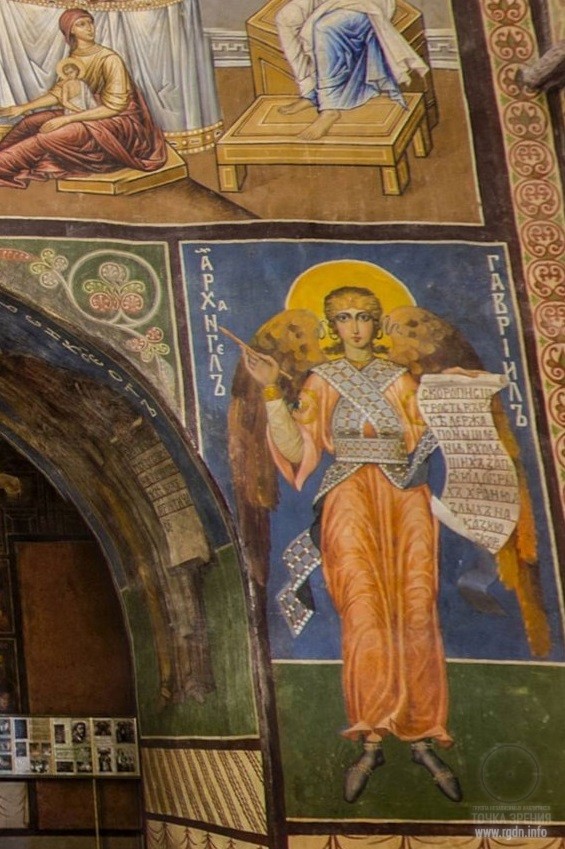
Perhaps, this has been done unconsciously and accidentally in order to create an atmosphere of antiquity in the museum? Or, maybe, this has been done deliberately and not accidentally in order to ensure that visitors and tourists would see an old scene, miraculously preserved since olden times with unclear remains of paints applied by our “primitive ancestors”, and would not be attracted to the essence of the images?
I don’t have a definite answer to the question, but “accidents are not accidental” as they say. Once I decided to carefully examine the scenes in front of me, my suspicion of non-fortuity was growing stronger every moment. I believe those who coordinated the church restoration, including UNESCO “experts”, did their best to conceal the essence of what is depicted on the church walls.
Please, feel the difference… While less significant images have been qualitatively and “responsibly” restored, the Christmas painting is still in awful condition. Let us try to lift the veil of this mystery. Below, under the painting there is a modest, hardly noticeable scheme of the image. It has been clumsily composed for the sake of propriety by the “caring” UNESCO people for future visitors of the museum.
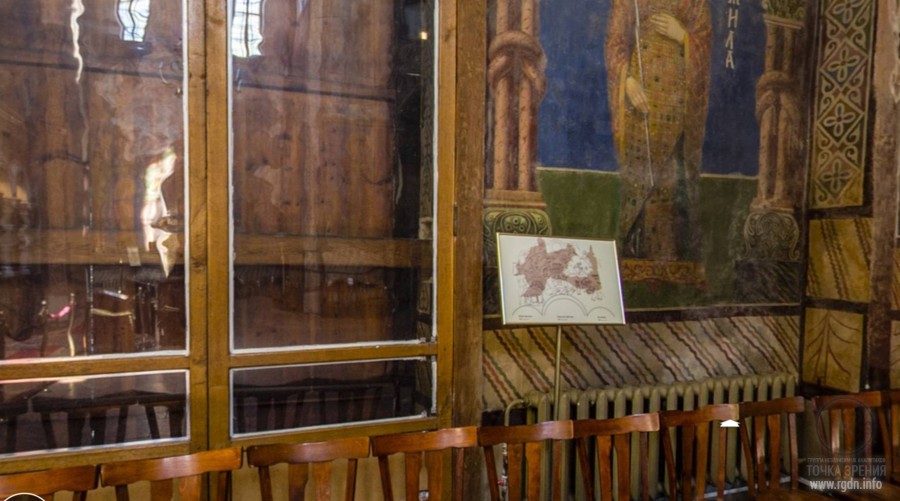
They were so skilful in destroying the substance of the wall painting that today, in our age of digital technology when it is possible to retrieve any image, you will fail to find this painting on the web, and even if you find it you won’t be able to discern anything on it. This is how our history, culture and priceless heritage are being ruined. Now, let’s figure out what is so neatly hidden from us. Here is the full scheme of the Christmas painting scene:
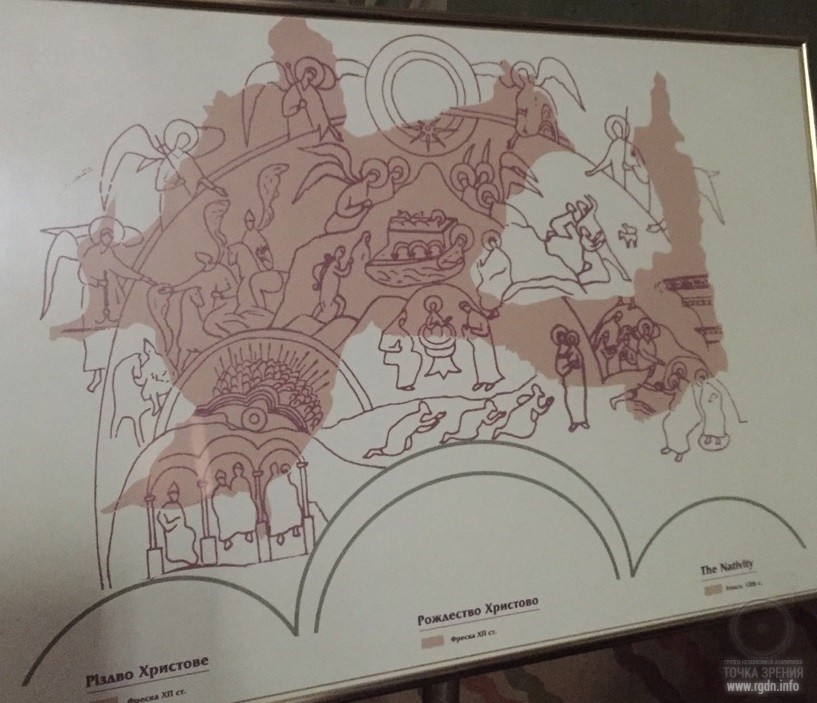
Let’s consider the painting components one by one. While we do this, below the images I will cite books by Anastasia Novykh, which precisely describe this scene:
1. Delimitation of the material world and the Spiritual World. According to sacral symbolism, the material world is depicted against a green background, while the Spiritual World is depicted against a blue one.
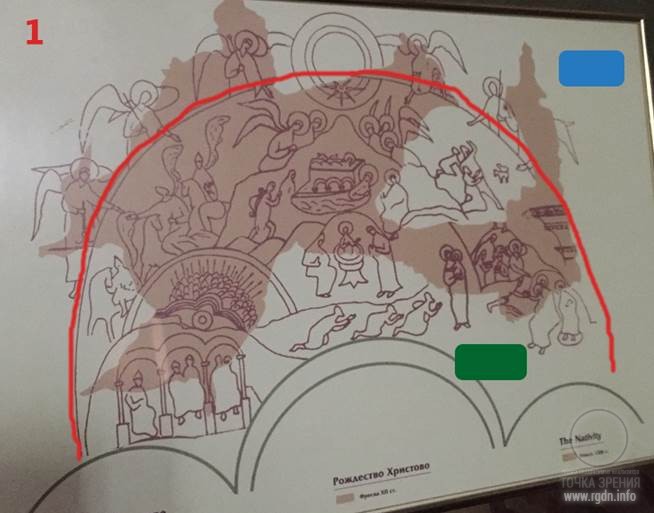
2. The seven Archangels-mediators between God and people. In Oriental traditions these are the seven Bodhisattvas of the spiritual abode of Shambala (Shambhala). The seventh Archangel is portrayed in a special way – as a circle that radiates light, which emphasizes the knowledge that the first Archangel is Gabriel who is the Holy Spirit Himself.
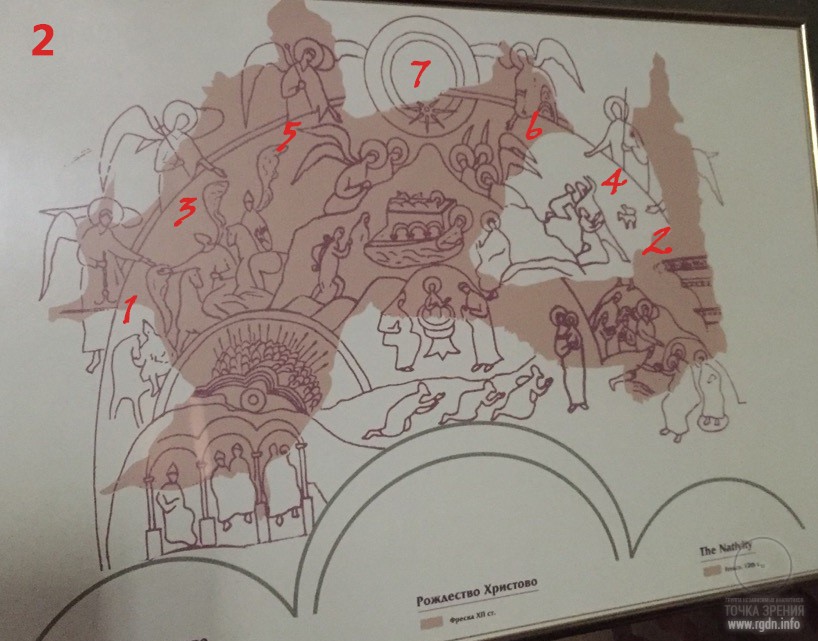
The seven Bodhisattvas rule Shambala itself. The eighth one is God who rules everything, including Bodhisattvas. The fact that these seven are often mentioned is due to their relevant activities. When a human being evolves spiritually (either within one life or more often through recurrent incarnations) he or she eventually gets, as Buddhists say, on the last step to becoming Buddha. Figuratively speaking, he or she graduates from the earthly life university and tries to defend his or her “diploma” in order to have the right to get to a higher level. At that, the seven Bodhisattvas represent the “certifying commission”. (The Crossroads by A. Novykh)
3. The mountainous abode of Shambala is depicted, where enlightened beings reside and from where they observe what is happening on the earth. The enlightened beings are portrayed as Angels with wings and nimbuses. We can see that the mountainous abode is situated within the material circle, but at the same time it is close to the Holy Spirit via its peak. At that, the Holy Spirit as if penetrates both the material and spiritual realms.
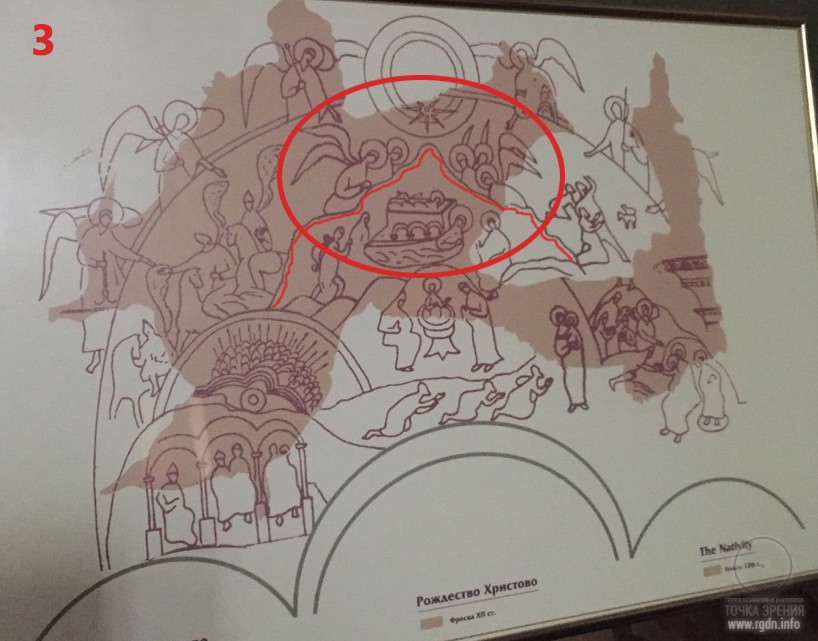
Shambala? Well, it is a kind of an abode located high in the mountains. But it is famous for its group of scientists who live there and have long surpassed the present-day mankind by their spiritual, scientific and technical level… In Shambala they study the most ancient primordial science of Belyao Dzy, meaning the White Lotus science, which includes everything and exact sciences as well. Moreover, this very science is the only source of all sciences, whenever studied by the mankind. (Sensei of Shambala – Book I by A. Novykh)
In the East, since ancient times people believed that Shambala’s the main centre of opposition to Evil and dark forces on Earth, being the primary source of knowledge and tremendous spiritual power. But I would like to notice that, although Shambala possesses all such features, in general it is neutral relative to the human society, giving people pure knowledge and full right to make their own choice between the forces of Good and Evil. Therefore, as a rule, it’s people following the spiritual path who spread the spiritual knowledge of Shambala in the human society and oppose Evil. (Sensei of Shambala – Book IV by A. Novykh)
Hence, Shambala is Shambala. It is neither a health resort, nor an exhibition hall or museum. One who is looking for Shambala has to look inside oneself, address oneself. For people Shambala means, first of all, pure knowledge which comes from the other side of consciousness and opens up to any person who works on oneself, on the purity of one’s thoughts and keeps predominance of agathodemon and Love for God… So, don’t look for it in the external world to be handed on a silver platter with a sham smile by those who use the name of Shambala for their greedy purposes as their one more “religion”, only because they are simply “too hungry”. You just need to look inside yourself and identify who you are in fact and why you have come to this world. (Ezoosmos by A. Novykh)
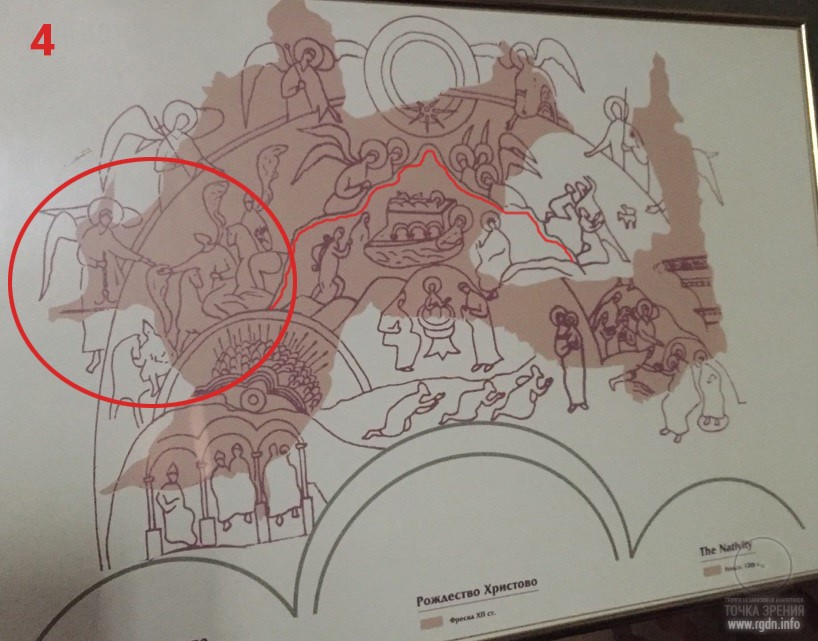
4. In this fragment we can see horsemen who are riding from the mountainous abode of Shambala. Please, note the horsemen have wings but no nimbuses, which clearly indicate these people are Mezhanins. Mezhanins are those who have access to Shambala and spread the knowledge from Shambala all over the world. Moreover, they get in contact with people. We clearly see the gesture – a horseman’s arm stretched towards the Archangel’s stretched arm, which symbolizes knowledge communication. At that, the horsemen are moving from the mountainous land (the Higher World) to the earthly world where people are.
There are a certain number of people in the world who have access to Shambala through the Threshold and communicate directly with Bodhisattvas or Mahatmas, whatever you may call these Scientists. In Rus, from the earliest times these people have been called Mezhanins. This word originates from the word “mezha” – a boundary that separates two planes, a border, a borderline, a junction, a frontier. In their turn, Mezhanins have disciples named Sokrovenniks. The latter possess certain spiritual knowledge, skills and internal vision, and can visit the Shambala Threshold. Sokrovenniks are exactly those who find necessary people with a big inner potential, people who can change the course of history. A Sokrovennik reveals certain knowledge to such a person, teaches and takes him or her onto the path of independent internal work. The Sokrovennik’s disciple becomes a Vezhah. In translation from the Old Russian language Vezhah means “knowledgeable”, “competent”. (The Crossroads by A. Novykh)
5. We see the earthly world, the world of people. As the Book of Ecclesiastes says, “What has been is what will be, and what has been done is what will be done, and there is nothing new under the sun.” The same thing is here. We see what has been done and what is being done in the world of people: human armies, princes and kings in their endless wars and pursuit of power and mundane welfare. Furthermore, there is a symbolic depiction of an arch with three vaults where princes are sitting, which indicates the three-dimensional material world, the world of the Animal Mind.
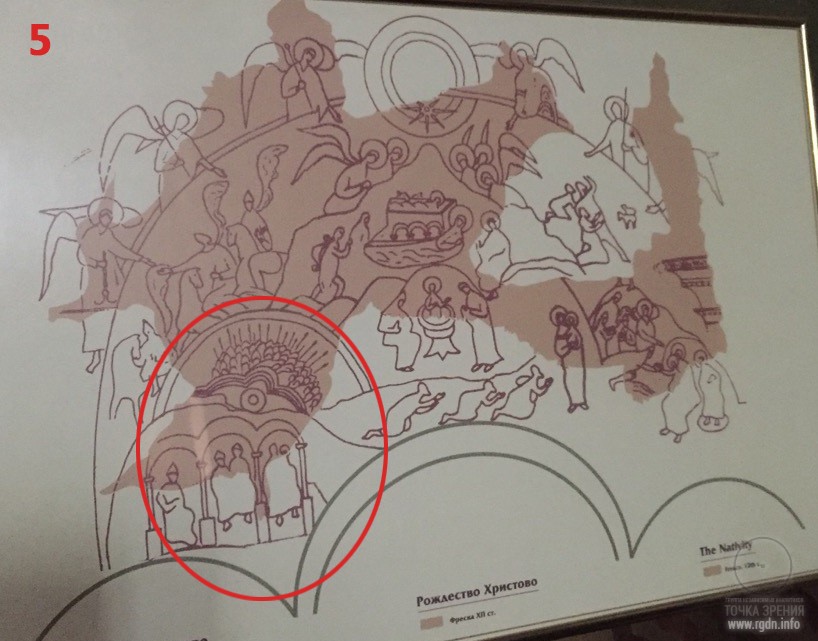
6. In this fragment we can see the tremendous role of the Mother of God in spiritual help rendered to people. In the lower part of the fragment people in a prayerful pose are addressing Our Lady. A little above a person with a nimbus appears from the water in a font that stands on three legs. This symbolizes the three-dimensional material world and the person’s spiritual transformation from it in a new realm. Still above, a man with a burden is surmounting a mountain, which symbolizes human movement towards the spiritual summit, towards spiritual perfection and salvation of the Soul. The man’s hands are in a prayerful gesture, and in front of him there is the ark of Our Lady.
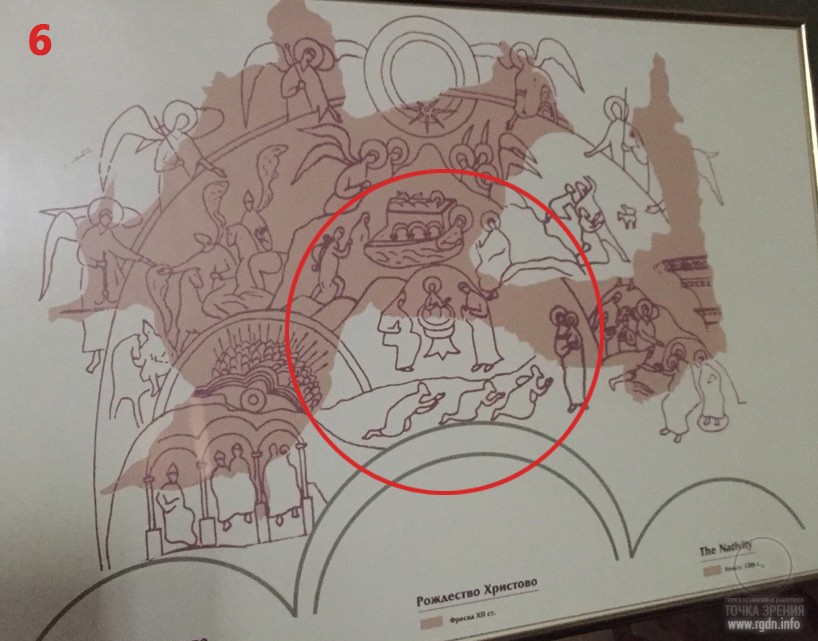
It is noteworthy that the Annunciation scene in St. Cyril’s Church repeats the scene depicted on the arch in St. Sophia’s Cathedral. Below there is a quote regarding this from the AllatRa book by A. Novykh.
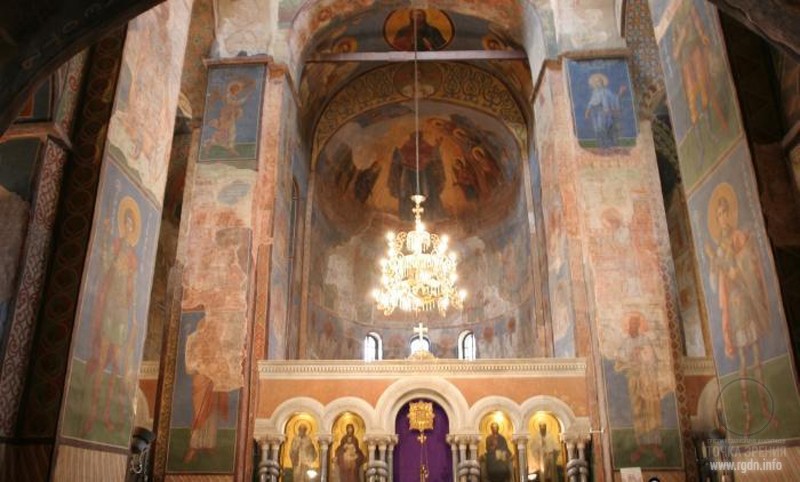
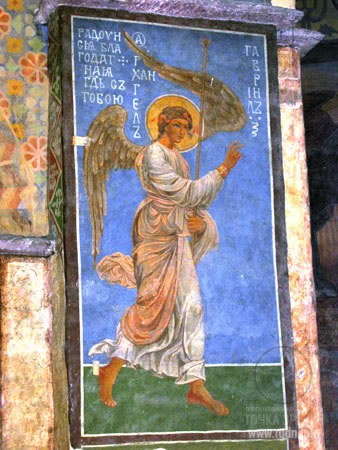
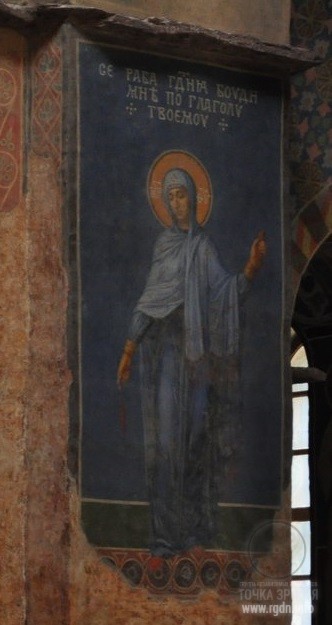
Rigden: … In the context of the story about Kievan Rus, I would like to draw your attention to another equally important page in history. Initially in Kievan Rus Archangel Gabriel and Virgin Mary were honoured together, as it should be in fact. Only much later, in the 15th century, people singled out the reverence of Archangel Gabriel from the cult of Annunciation of Our Most Holy Lady, although this is incorrect. Where the Virgin creates in a holy way, there is always the Holy Spirit with Her. By the way, in Slavic beliefs (before Christianity was adopted) the supreme male and female deities were revered jointly as a couple, speaking in our language, in the meaning of a spiritual symbol of the divine Lotus (the plan) and the creating Allat (implementation of the plan).
Anastasia: Yes, this may be traced back to the mythological characters of the Slavic sacred legends which have been preserved since ancient times.
Rigden: Regarding Archangel Gabriel and Virgin Mary, on the altar pillars of the main eastern arch of St. Sophia’s Cathedral in Kiev, where the Virgin Orans (Oranta) is depicted, mosaic images of the Annunciation have remained until today.
Anastasia: Yes, on one of the pillars there is an image of Archangel Gabriel, the fingers of whose right hand are joined in a blessing gesture. On the other pillar there is the Mother of God with a spindle in her hand, spinning the spiritual thread of human life.
Rigden: I would like to mention that in the Old Slavonic language the word “веретено” (spindle) is linked to the word “вертеть” (to spin) (a vortex, spiral movement). By the way, the Slavs were not the only ones to have such word. The ancient Indian word “vartanam” also means “spinning”. Since ancient times, in the spiritual aspect a spindle has been considered to be a magic tool given from above. That is, speaking in modern terms, it is a symbolic description of a prayer, meditation or spiritual practice. Spinning out of threads by means of a spindle was a certain spiritual symbol known to many peoples as the union of the “Earth and Heaven”, the union of man during his fleeting life with the spiritual divine nature (the Soul). In religious art a thread symbolised human spiritual life, and in the global meaning it was a symbol of time, a connection between the past, the present, and the future. It was a spiritual component which united all things like a thread connecting all pearls (souls). Many ancient peoples depicted the “Great Mother” with a spindle in her hands. (AllatRa, pages 512-515 – allatra.us)
7. In the next fragment we can see three people. Two of them are kneeling in a prayer pose, looking towards the Spiritual World sphere. Two lambs are in front of them as a symbol of the sacrifice of their animal nature. The third man is in a frightened, as if rejected pose; with his hand raised he as if tries to protect himself against the Spiritual World. This symbolizes a person for whom material living is more important than spiritual life. He fears the Spiritual World because he is attached to mundane amenities.

From the AllatRa book by A. Novykh:
In religious beliefs of many peoples, sacrifice is a propitiatory or gratifying offering to all sorts of deities, mainly from fruits of the earth or from the kingdom of animals. It is “cleansing from filth and attaining spiritual purity”. Let us take, for instance, the Bible which describes how the sons of the progenitors offered sacrifices to God: Cain made a sacrifice from fruits of the earth, while Abel sacrificed from his flocks. In modern world religions, sacrifice is regarded as a symbol of offering from what you own of something that is dear and pleasant to you.
But if we delve into the spiritual origins of such beliefs and symbolic rituals, we can understand what the true sacrifice to God is, which involves a relationship between God and a human being. The real sacrifice to God is when a person sacrifices his or her Animal Nature at the altar of his or her life, that is, the person renounces his or her numerous desires, thoughts, fleeting and temporary illusions, thus opening for oneself a spiritual way to true Eternity – to the world of God. A long time ago, at the dawn of mankind this was explained to people in such a way that the qualities of the Animal Nature are like fruits of the earth, which at first seduce the eye but then quickly rot. It is only by sacrificing these transient things to God that you have an opportunity to pass into His Eternity, i.e. by working on yourself and rejecting temptations of the Animal Nature. And, if you develop spiritually, do good and help to awaken the other people who live on instincts like animals, then for God this is akin to the joy you feel from a good brood of your herds.
It is no coincidence that the place for sacrifice or communication of a believer with gods, which is now called the altar (from the Latin “altaria” and from “altus” meaning ‘high”), in ancient times was originally indicated simply as a sign or symbol, mainly in the form of a square, circle, oval (cylinder), or cube (rhombus). All such inscriptions served as clear symbols of spiritual practices which a person was performing in an altered state of consciousness and at the time of which he or she was communicating directly with God at the deep level of feelings. And such a moment of communion with God through feelings is possible only when a Personality is fully immersed in this process, and when he or she is dominated solely by the Spiritual Nature. By making such a Choice in favour of the spiritual world a person thereby consciously “sacrifices” the domination of the Animal Nature in his or her consciousness, which is usual in the material world.
8. In the centre of this wall painting the Holy Spirit is symbolically depicted as a shining circle. In Orthodoxy he is called the First Archangel or Archangel Gabriel. The Holy Spirit is depicted separately, not like the other Archangels, but his symbolic image (the shining circle) is present in the image of each spiritual being in this painting as a nimbus. This evidences that in olden times people knew that the personality (spirit) of every spiritual being represented a part of the Holy Spirit. Another significant symbol in this painting is the seven-pointed star that indicates the seventh dimension from where the Spiritual World starts actively manifesting in our universe.
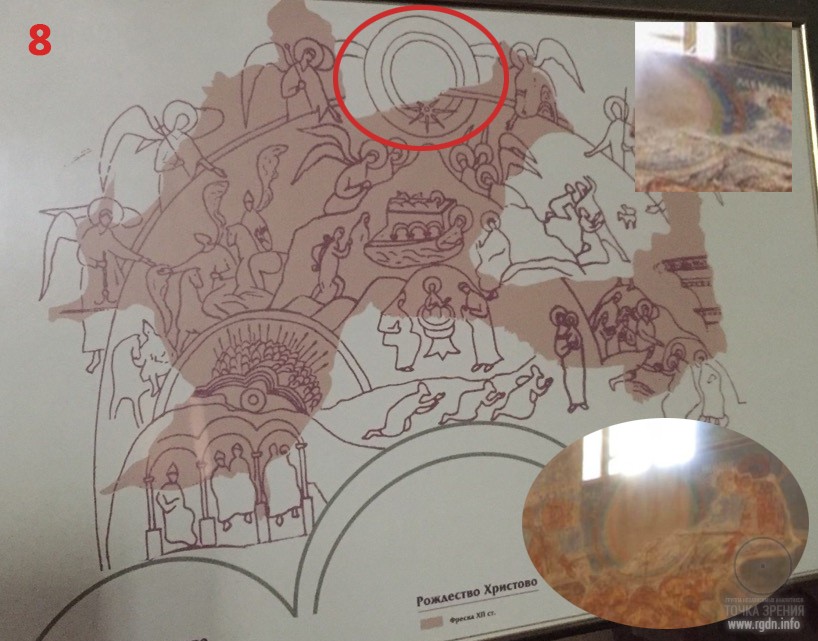
From the AllatRa book by A. Novykh:
There is certainly symbolism here, but the sacrament of the Holy Spirit is also present in this, for anyone who addresses with faith receives requital. Generally speaking, a human being can come to know God only through the Holy Spirit, since the latter is the first assistant and mediator between God and man. He is multiple in His manifestations, but His Essence is single. It is difficult for people to realize what the Holy Spirit actually is. But in no religion any sacrament that awakens in a person Love for God and Faith in Him can take place without inspiration of the Holy Spirit. For people the Holy Spirit is God’s power, His Ear and His Voice...
Dimensions were conventionally depicted as a number of steps of a truncated pyramid or a staircase, parts of patterns (lotus buds or petals, contours of mountains, zigzag lines), circles inside a circle, little lines, grains, and points. As a rule, their number was 3, 4, 5, 6, or 7. The number of 3 identical elements in a symbol usually indicated the three-dimensional space. 4 meant three dimensions plus the fourth one – time, and it could also serve as a symbol of the four Aspects. 5 represented the five-dimensional space, but this figure was generally associated with a five-pointed star as one of the symbols of the feminine principle, a sign of the manifested forces of Allat in the fifth dimension. 6 stood for the sixth dimension, which is the highest dimension reachable by a person with a material dominant, from where he or she can influence the material world in an altered state of consciousness. At that, the presence of seven identical elements in a pattern meant the 7th dimension, indicating a perfect person and the structure of the world up to the 7th dimension, or the concept of heaven, Nirvana and liberation of the Soul.
Just imagine how much real knowledge was imprinted in this wall painting and how skilfully it was destroyed or concealed from the eyes of the majority of people. I don’t know about you, dear readers, but I have come to distrust such “fortuities” long ago. Every new fact further unfolds the picture of global eradication of the true primordial knowledge contained in architectural and cultural monuments of the past. At that, the interference of Archons and the international organisations controlled by them, such as UNESCO, is totally obvious.
Yet, let us recur to our subject and move to the opposite wall, namely to the mosaic called The Assumption of the Mother of God. Having approached it closer, you would see a no less grievous situation associated with the scene restoration.
Here is a conventional description of the Assumption of the Mother of God iconography. The composition of the Assumption icon is divided by a mental horizontal line into two parts of meaning. In the lower part Our Lady’s body is portrayed on the deathbed, surrounded by the mourning apostles. In the upper part Christ holds the soul of His Blessed Mother in His arms, being surrounded by rejoicing Angels. The earthly sorrow below is opposed to the joy of the future age. (Source )
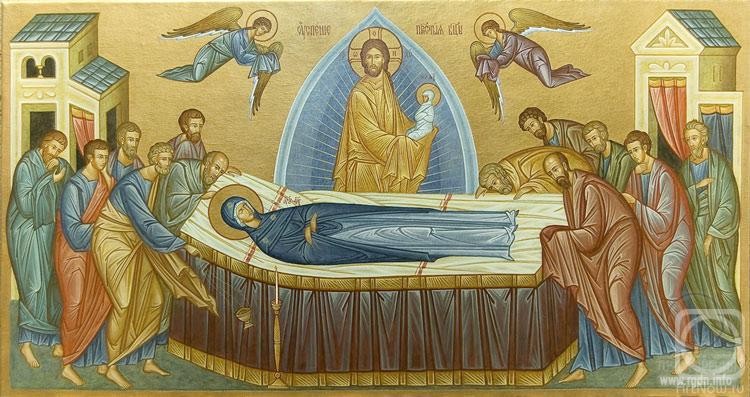
Most probably, consciousness will draw a conventional picture for you. Taking into account the restoration status of the painting, where anything can hardly be discerned, you would most likely glance at the mosaic in decency, see nothing special on it, and move further with an air of a responsible tourist. This is exactly what the “valiant” UNESCO restorers wanted to ensure.
Let’s see what is depicted in this ancient wall painting:
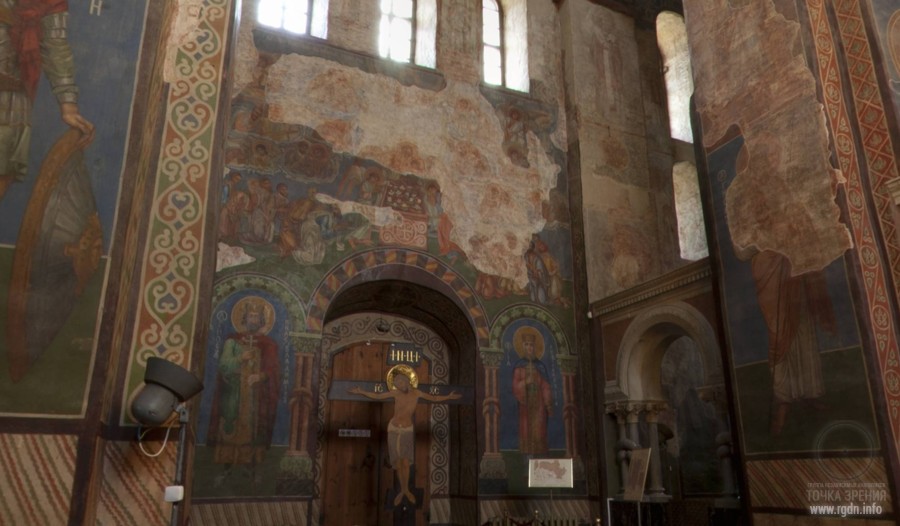
Nonetheless, we will try to lift the veil of the mystery and responsibly figure out what the ancient masters depicted almost a thousand years ago on one of the main walls in St. Cyril’s Church. For a start let’s look at the “modest” scheme in the corner under the mosaic, the purpose of which is to tell tourists the scene name and, as I believe, to discourage them from any desire to grasp the meaning of the image. Given the carelessness with which the scheme has been made I simply cannot find any other explanation for their intentions. Look at it yourselves:
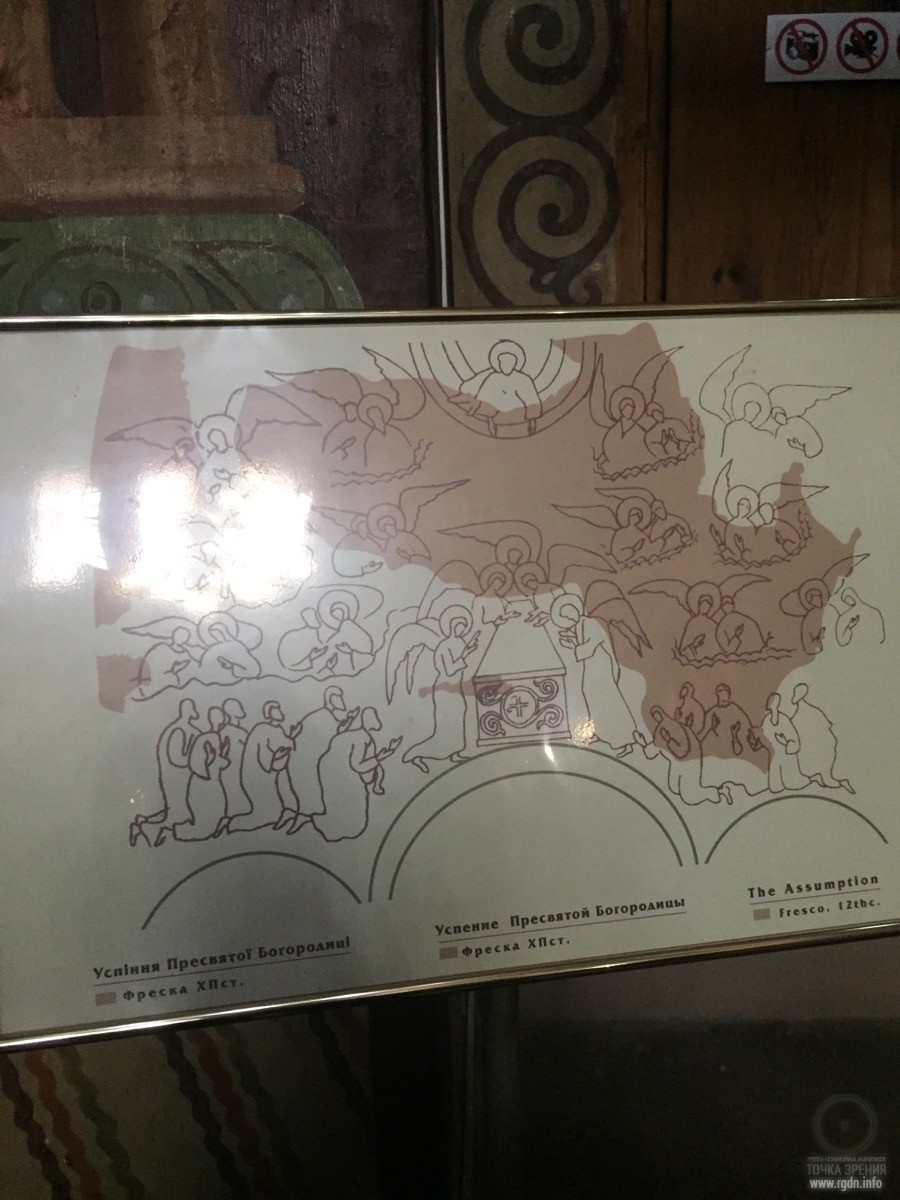
Now let’s figure out what is depicted here.
1. There is delimitation of the material world and the Spiritual World. In line with sacral symbolism, the material world is depicted against a green background, whereas the Spiritual World against a blue one.
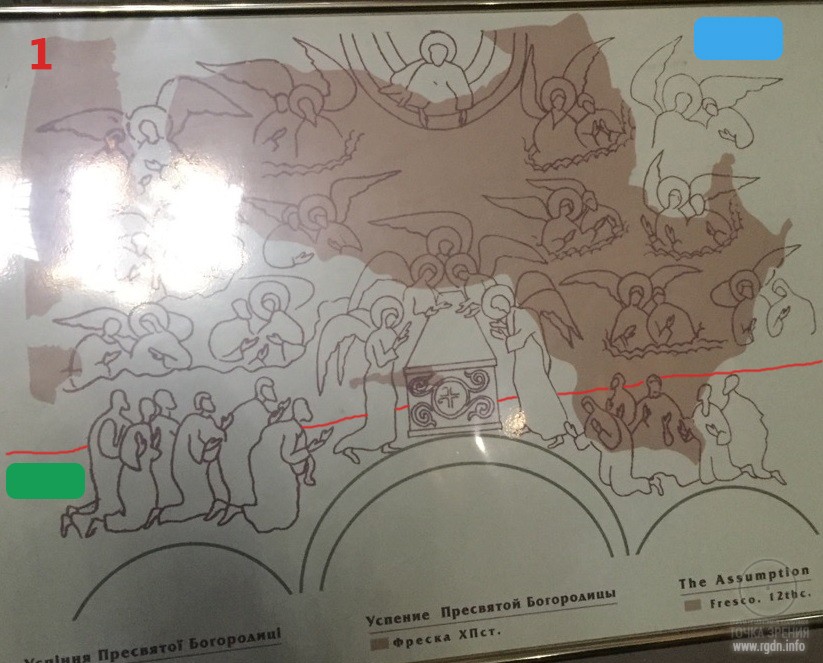
2. In this part of the fresco there are people who follow the spiritual path, which is evidenced by their kneeling prayer pose. At that, their eyes are directed at and arms are stretched towards the image centre.
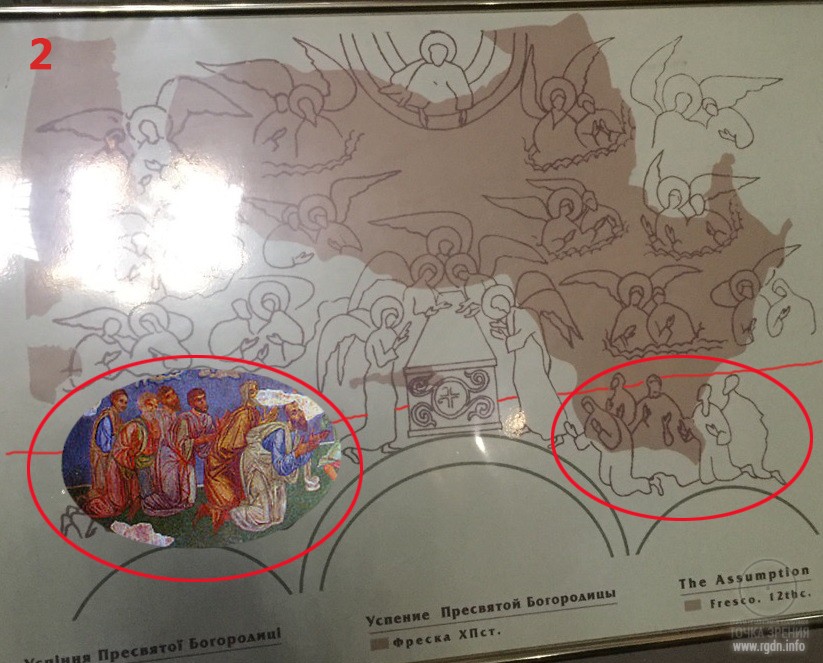
3. Above every person, on a cloud, there are two images – an Angel and a human being. With their gestures and face expressions they are as if having a dialogue with the person who follows the spiritual path, which symbolizes the duality of human nature. In particular, an Angel means the spiritual nature, and a human being means the material (animal) nature in a person.
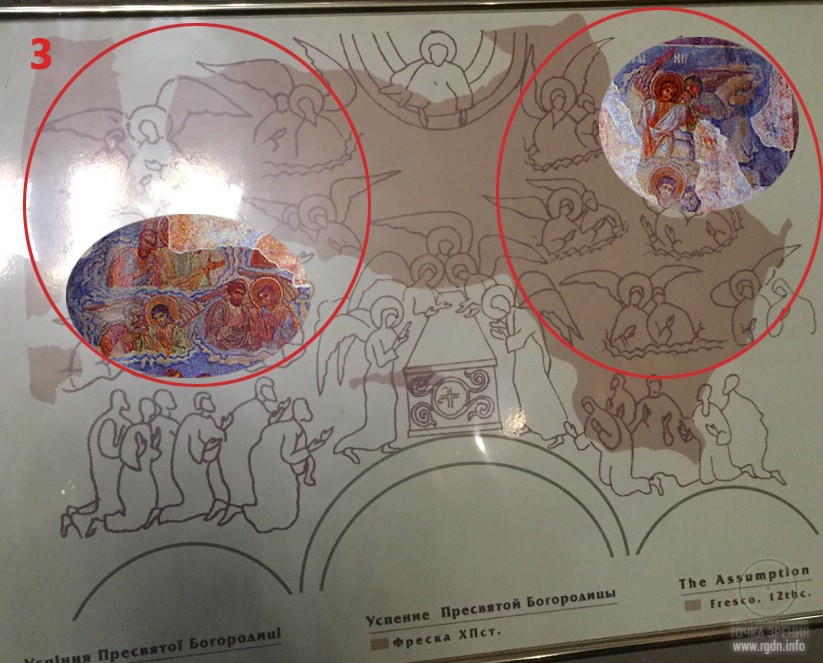
4. In the painting centre there is a plane hexahedron. Its base rests on the material (three-dimensional) world, while its surface is in the Spiritual World area. Angels observe what is happening on the surface of water which the hexahedron is filled with. The inner filling of the hexahedron resembles dark (muddy) water (a bog). On its surface we can see blossoming lotus flowers. Moreover, it should be noted the Angels are portrayed beyond the hexahedron and at the same time surround it on all sides, while their attention is directed at the lotuses on the water surface. We can see that the Angels observe and stretch their arms in a caring gesture towards the blossoming flowers. It is also noteworthy that the Angels’ eyes are directed at the flowers on the water surface, but not at the people moving to the hexahedron in prayer.
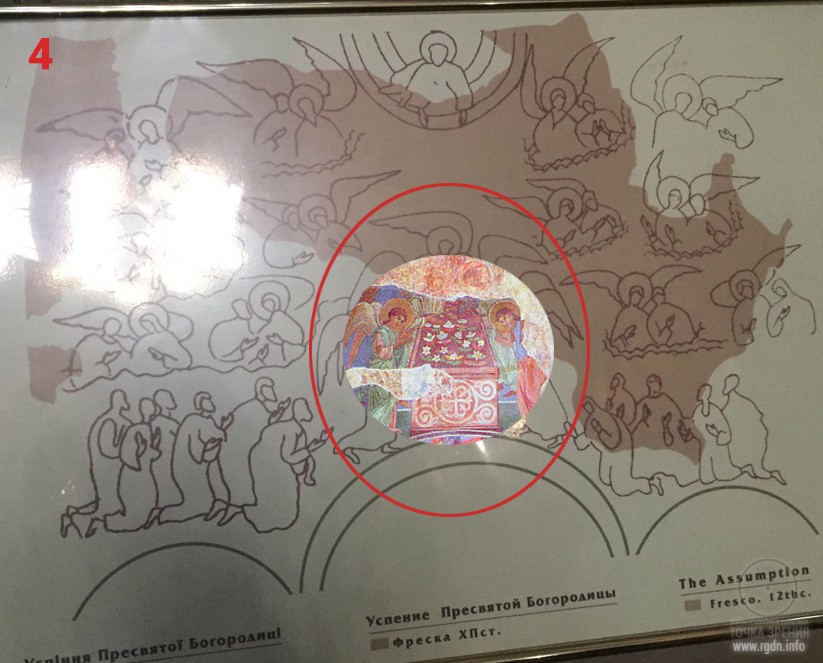
From the AllatRa book by A. Novykh:
In ancient times in the East, the stages of mastering the path of Bodhisattva by a human being was figuratively compared to a blossoming lotus flower when it grew out of the muddy water and showed a mature, pure white flower on its surface. The beginning of a person’s spiritual path was compared to a lotus seed that sprouted on the bottom of a swamp or lake by which the three-dimensional material world was meant. The person’s spiritual growth, his or her fight against the Animal Nature, removal of doubts and earthly desires, work on the discipline of thought, and mastering of spiritual practices was likened to the growth of a stem, its passage through the thick muddy water as it carved its way to the surface. Fusion of the Personality with the Soul and spiritual liberation when the seventh dimension was attained, when a new Spiritual Being was conceived and when it became noticeable to the spiritual world, was compared to the appearance of a bud above the water surface, in other words its manifestation in a totally different world and, most importantly, to the accessibility of direct rays of the Sun (the power of the spiritual world) not distorted by the muddy waters, under which (the rays) the bud began to unfold its snow-white petals. Its every new unfolded petal personified spiritual attainment of the next dimension by the Personality. And this process went on until the Human Being learned all the 72 dimensions, in other words until all 72 petals completely unfolded and a magnificent lotus appeared in its entire divine beauty under the shining rays of the mighty Luminary that created him or her. So the Human Being, having reached the level of Bodhisattva, stood in all his or her spiritual wealth before the One Who created this divine seed and gave it eternal life.
5. In the middle of the upper part of the fresco Jesus is portrayed in radiance of the Holy Spirit. By analogy with the Christmas fresco which we have considered earlier, there are two important elements. Number one is the Holy Spirit Himself, depicted as a spreading shining circle. Number two is that Jesus is inside the circle; hence, He resides in the Spirit and is a part of the Holy Spirit. Just like the nimbuses around the Angels, this evidences His sanctity (involvement in the Holy Spirit).
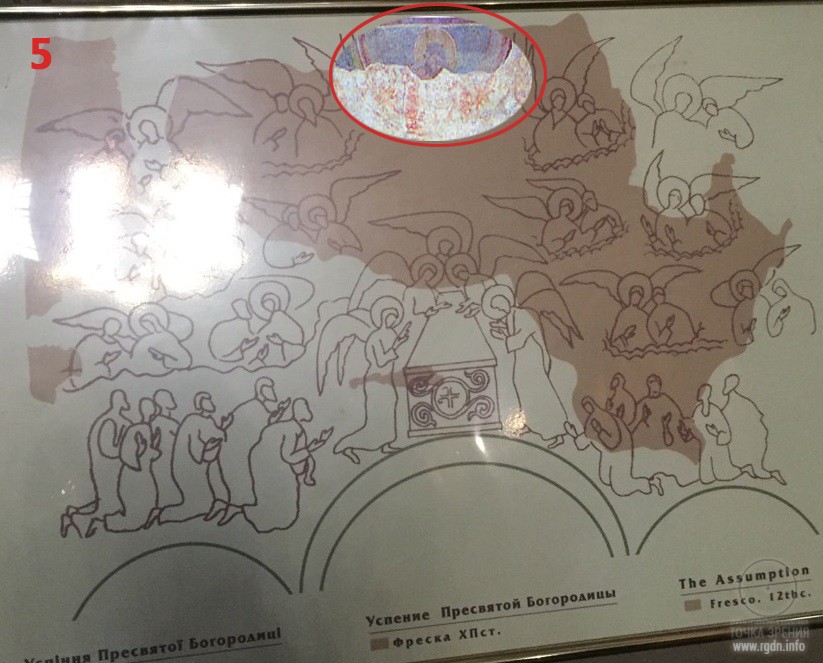
I would like to draw your attention to several other interesting points in the history of St. Cyril’s Church.
In 1860, 12-century frescoes were discovered in St. Cyril’s Church. The discovery was made by the priest Orlovsky. When a piece of lime fell from the wall during the service, the priest saw a face of a saint there. The discovery was of a state importance. It was decided to clean the frescoes. The famous architect Alexander Beretti was appointed to lead the restoration works. However, the works were done poorly:several frescoes were almost destroyed. A scandal broke out, and Beretti was dismissed. The famous art historian, archaeologist and artist Adrian Prakhov became his successor. The works were coordinated by the Emperor Alexander II himself.
The frescoes were cleaned. It turned out they covered the walls not entirely, so it was decided to fill empty places with new paintings applied on fresh plaster. Teachers and students of NikolaiMurashkoKievArtSchool were invited to create paintings. Ivan Izhakevich, the future classic of Ukrainian visual art, was among them.
But the most valuable are surely the works by Mikhail Vrubel whom Prakhov invited later. It is now said that Vrubel’s masterpieces in St. Cyril’s Church are of planetary significance. In terms of their artistic value, the wall paintings by Mikhail Vrubel may be compared with the 12-century frescoes in St. Cyril’s Church. His most impressive works of art include the multi-figure composition The Descent of the Holy Spirit, as well as Archangel Gabriel, Cosmos, Moses, and The Graveside Lamentation.
Now, let’s walk up the narrow stairs inside the church northern wall and enter the chorus premise. Our attention gets immediately absorbed by the painting created by Mikhail Vrubel on the vault and called The Descent of the Holy Spirit.
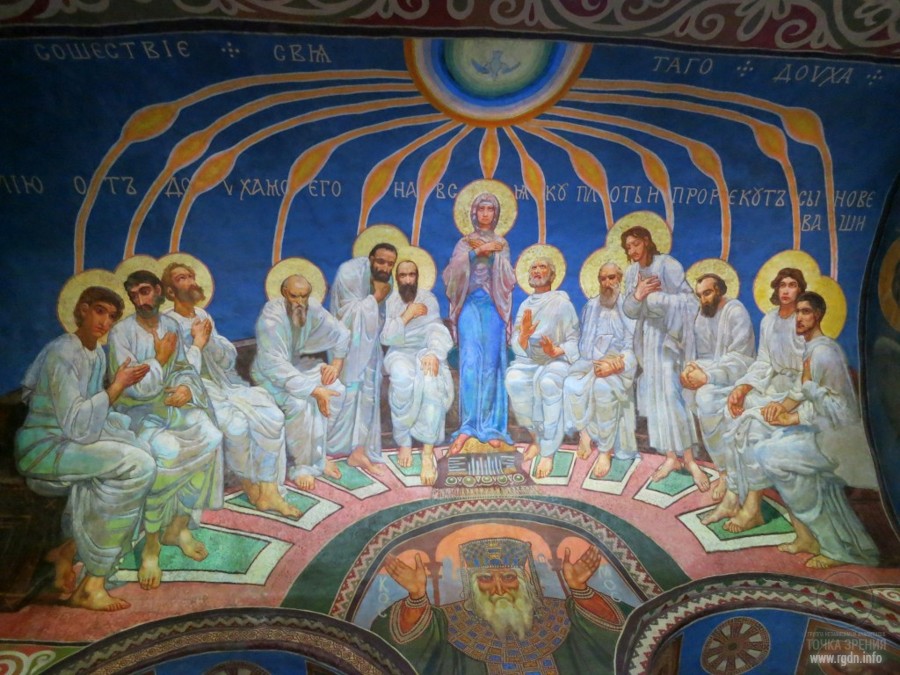
Let me share my feelings when I was looking at this painting. At that moment I felt peace, conciliation and overwhelming quiet joy. Time as if slowed down, troubles and thoughts came to the background. A mysterious longing for something native and dear rose from inside the chest and captured me entirely.
Well, let us analyse the image from the perspective of sacral symbolism and knowledge, and compare revealed symbols with the information we already possess.
In the upper central part the Holy Spirit is depicted as a shining circle. From Him “channels” filled with light flow and adjoin nimbuses of the apostles. Inside the Holy Spirit we can see sacral colours – green and blue.
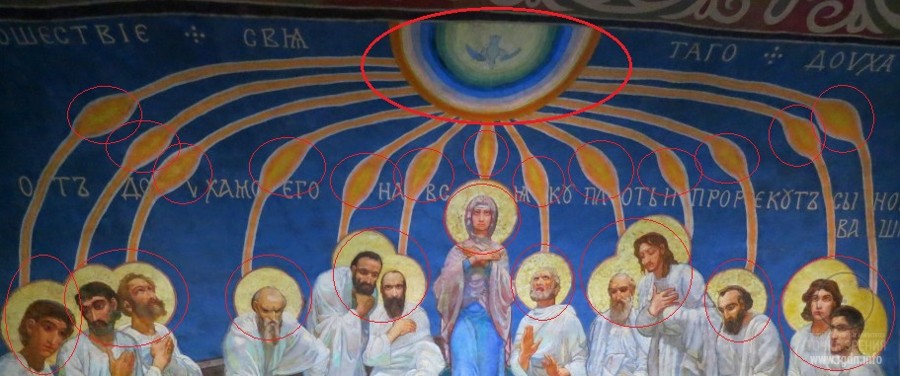
Here is what the AllatRa book says about these colours:
It was considered, for example, that if a person tastes the spiritual gifts of the goddess Hathor, this will give him or her more spiritual powers, and she will help the person pass from the earthly world to the other (spiritual) world. Due to this, the following epithets were bestowed upon her: the Great Mother, the Goddess of Love, spiritual joy, “the one shining in the rays of Ra”, the Great Woman, the Creator of all living. Among additional associative designations that symbolised her were sycamore as the “Tree of Life” as well as symbols of eternal life – the colours green and blue, which, as legends said, were commanded by her. The latter is associated with the secret knowledge about the wave nature of man and the moment of spiritual transformation.
Having encountered such information, I attempted to retrieve similar one and did succeed to find it in Ancient Egypt.
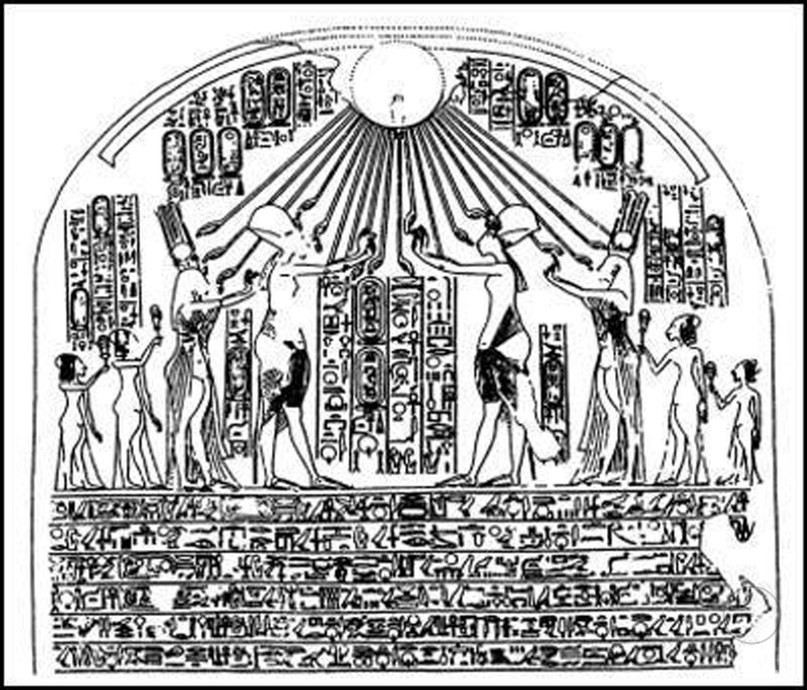
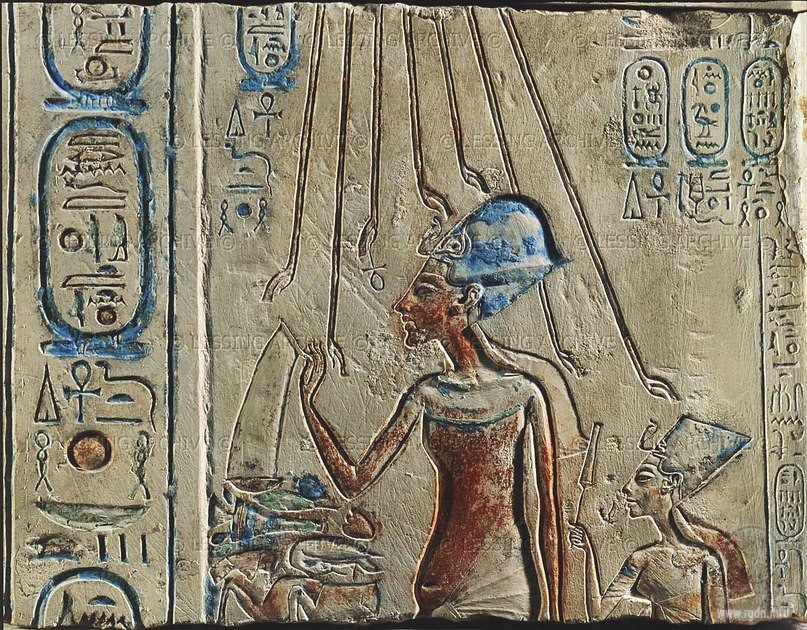
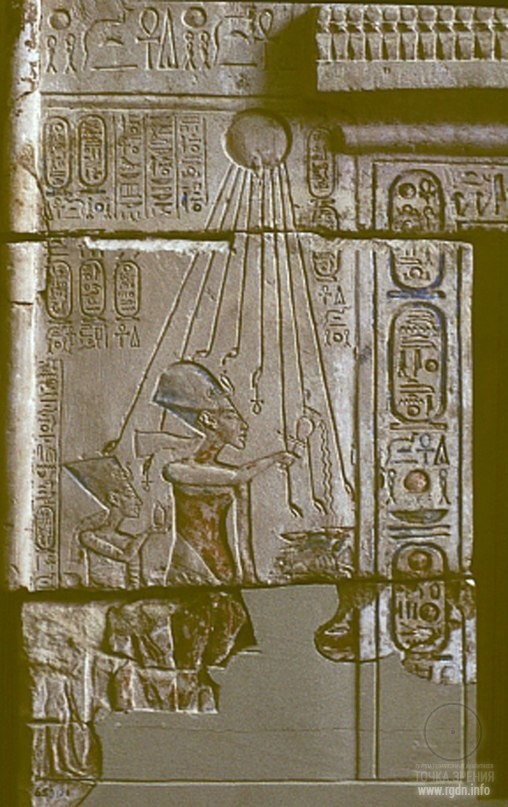
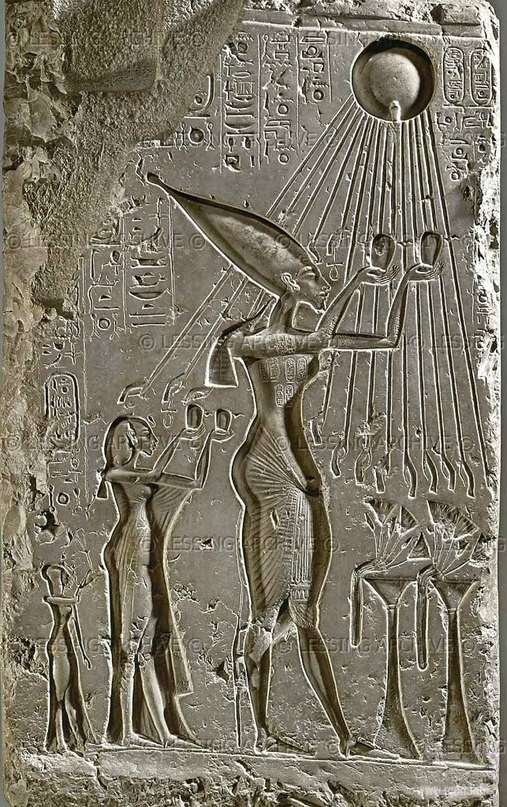
This is a striking likeness indicative of the single root of primordial knowledge in Ancient Egypt and Kievan Rus. Thus, the Holy Spirit is depicted as a shining circle, with the same channels of light flowing from Him to people’s nimbuses (heads). Furthermore, the ancient Egyptian bas-reliefs are executed in the same colours – green and blue.
Moreover, there is a peculiar bulge in the form of a tank on the channel that connects the Holy Spirit with the person’s nimbus (a nimbus is a traditional symbol of human sanctity). At that, on 27 September 2015, for the first time in modern history Dr. Igor Danilov publicly voiced on AllatRa TV that each human personality is a part of the Holy Spirit. Within a very short period of time this TV program entitled Unity has been viewed by millions of people on the web and drew a wide response:
I guess such bulges exactly represent the human personality, the human spiritual component that is inseparably connected with the Holy Spirit. Hence, we come to understand what it means “to gain, to accumulate the Holy Spirit”.
Looking further at The Descent of the Holy Spirit painting, I discovered more primordial knowledge of the human being and one’s spiritual development. For instance, there is a diagonal cross symbolizing a person who possesses knowledge of the human energy structure; a cube symbol composed of two squares inscribed in one another, which points at transformation of the human energy structure when the personality is fused with the soul. Besides, the entire composition contains same symbols of the basic spiritual knowledge transfer as everywhere in the world: the AllatRa working sign, lotuses, circles, cubes, rhombuses, pyramids, crosses, squares, a symbolic image of the four Aspects. More details may be found in the AllatRa .
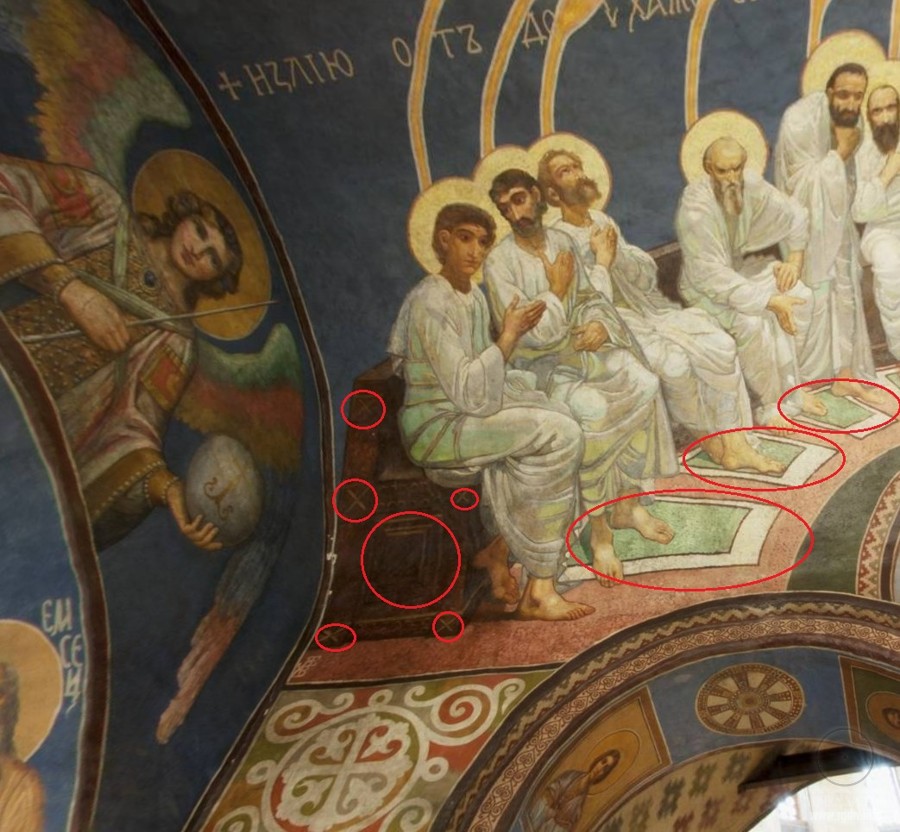
In this image there is also the AllatRa sign and the symbol of Allat power (the triangle with its apex pointing downwards). Our Lady stands on a rectangular base, the foot of which is decorated with the AllatRa and Allat signs (the latter is represented by the triangle with its apex pointing down). Our Lady’s right foot points at the corner of the rectangular base, which is a symbol of the energy structure of a person who has achieved spiritual liberation (a cube set on one of its corners). On the toe of Her shoe there is a blossoming lotus flower that also symbolizes the human spiritual path. In the middle of Our Lady’s image, approximately in the place where the soul is located, there is fancy depiction of the AllatRa sign. It should also be emphasized that in this painting Our Lady is in the very centre among the rest of the apostles and the closest to the Holy Spirit, which indicates Her particular role and spiritual power as of the first and beloved disciple of Jesus Christ.
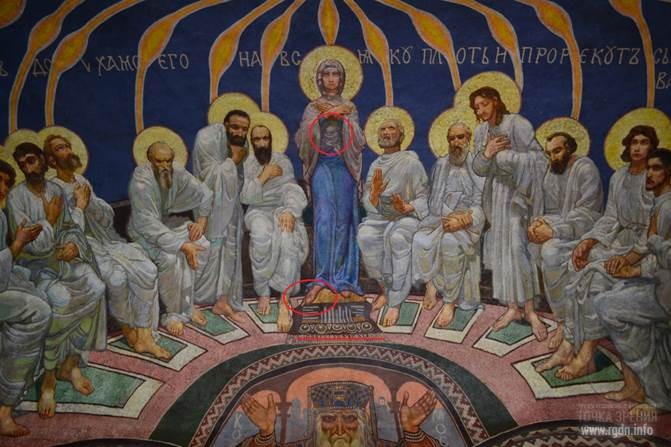
In the lower part of the image the Almighty Lord is portrayed. He is the Single One who created everything and by whose Will the entire space, the whole manifested world exists. Vrubel called this part of the painting Cosmos.
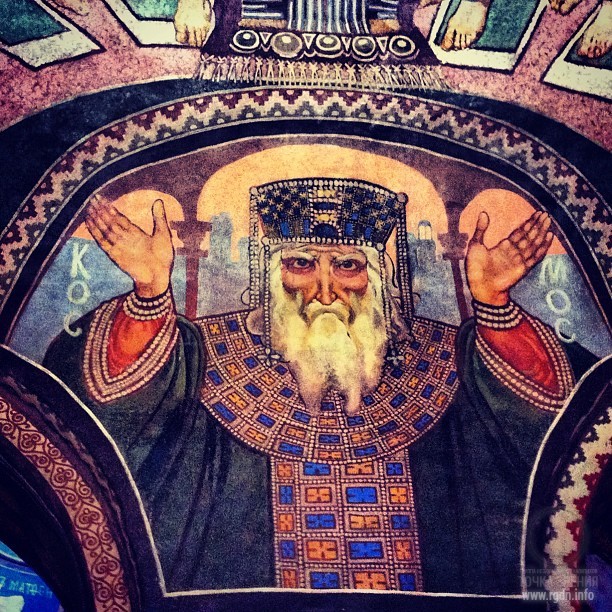
I had to leave with regret and unwillingness, though the elevated feelings which filled me when I was staying in the church and viewing this particular wall painting invisibly accompanied me for a long time thereafter.
However, those were not all revelations upon my visit to St. Cyril’s Church. Another surprise was in store for me at the exit. I did not notice the wall painting in the beginning, because when I was entering the church I was attracted by what I saw ahead. Yet, having examined the church, being full of inspiration and insights, I finally approached the exit and so this:
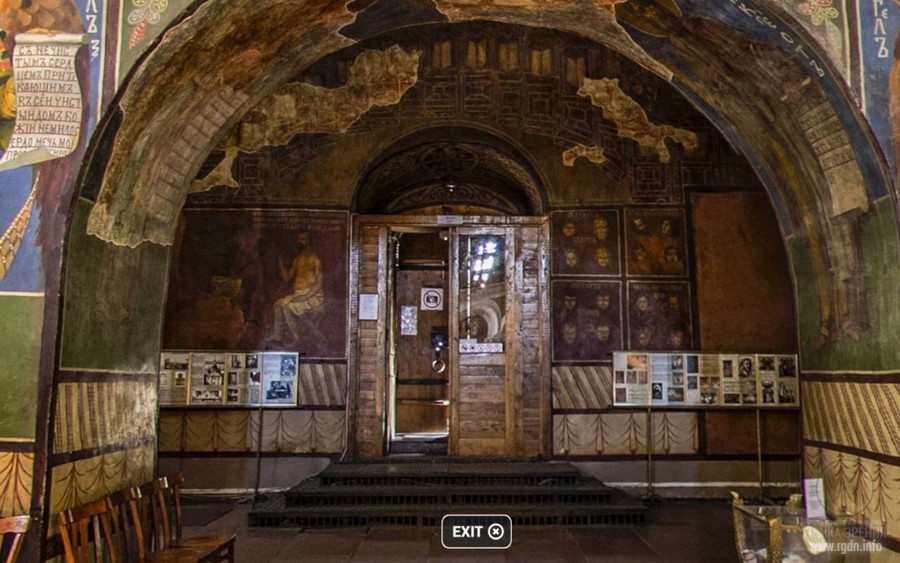
So, what else did the remote ancestors of the Russian people want to communicate to their descendants when they were erecting this church? A person comes to this church, gets filled with knowledge and understanding of the world and humanity, gains inspiration and spiritual fullness, and then he or she approaches the exit and sees a reminder intended to help him or her move along the life after he or she leaves the church. The first part of the reminder (on the right) tells me that I am leaving the spiritual temple and seat and return to the illusory world which is exactly hell for my spiritual nature.
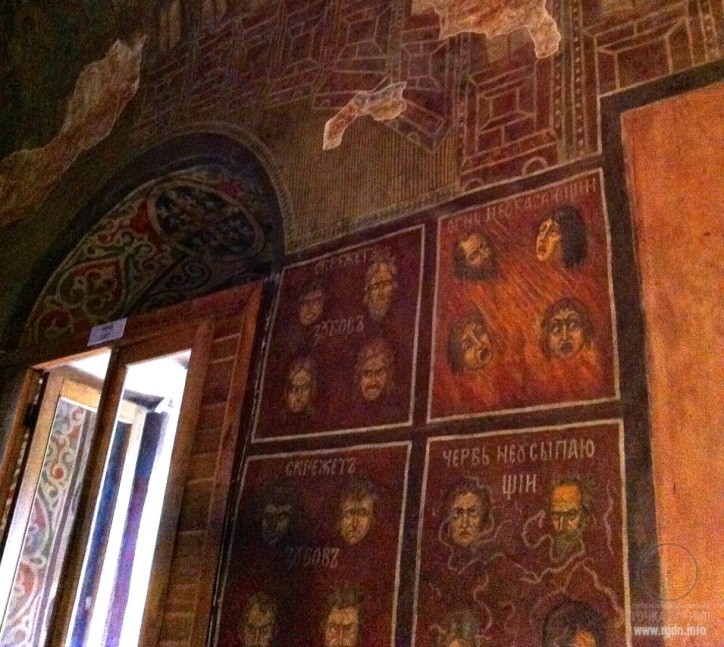
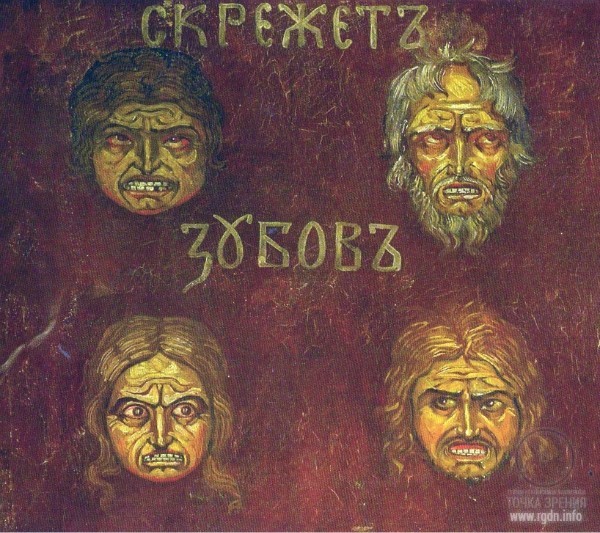
As you can see, when a person is coming out of the church he or she should remember the world around is not a place for idle stay, but a true hell for the Soul. Hence, in order not to stray from the spiritual path one should never forget this.
To the left of the exit there is another important reminder of the animal (demonic) nature in a human being, with which one has to coexist in this life:
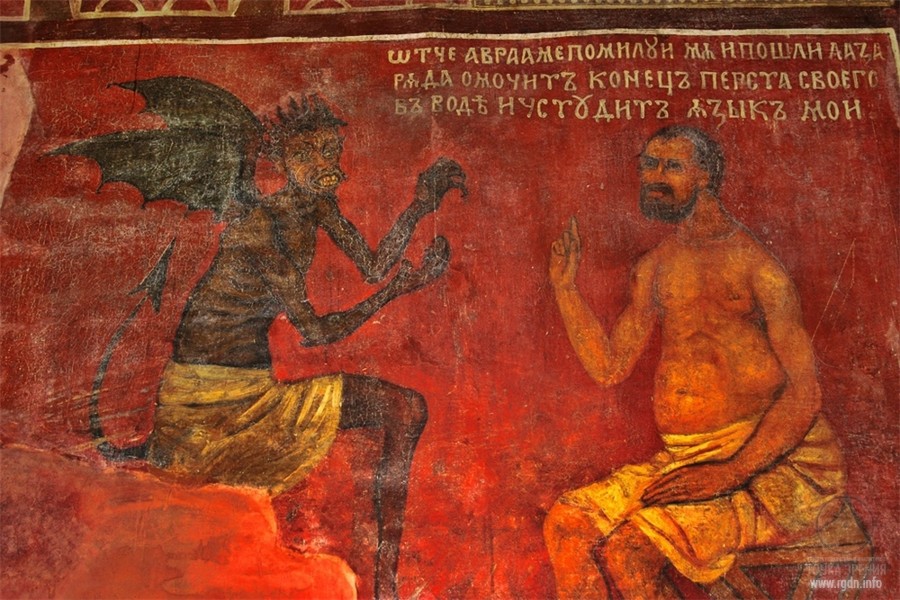
Let’s consider what we see here. The general tone of the painting points at the environment where the action takes place: it’s a burning flame of hell. Then the fresco shows two interlocutors facing each other in debate. On the left there is a black demon (evil spirit) with typical black wings and a pointed tail. His mouth is in a conversation expression and his hands make gestures of persuasion and active discussion. On the right there is a man listening to the demon, with his hand raised in a warning gesture as if in an attempt to object to the demon. The entire scene shows this is not a fleeting event, but a long debate, since both interlocutors are in comfortable sitting poses and in parity relationship with each other.
It turns out that, having got filled in Spirit and leaving the church, a person should remember he or she returns to the cruel world of the material (animal) mind, where his / her animal nature will always accompany him / her. The demon will constantly try to tempt the person with his mundane temptations. Moreover, this reminds one that the demon-tempter is not somewhere in a far unknown place, but always inside one’s consciousness – in the thoughts inspired by the animal nature.
Here is how the AllatRa book by A. Novykh describes this:
By the way, the Sanskrit word “ad” (the Russian transcription of the word “hell”) means “to eat”, “to devour”, “to consume”, or using the Old Russian word – “жрать” (“to gorge”). Ancient people regarded this material world as that very place which religions today call hell, and it was depicted as a monster which devours people, their destinies and Souls. But if a person yearns day and night to save his or her Soul and works on oneself every day, this gives him or her a chance to forever leave the boundaries of the material world, go beyond sufferings and constant rebirths…
… it is very important for a living Personality to do everything possible and impossible in life to unite with his or her Soul. The objective of the Animal Nature during the Personality’s life is to divert the latter from the Spiritual Nature by any means, whether in thoughts, desires, actions or deeds, so that the person would covet for the material, earthly, and mortal.
In this very place over the exit there is one more important instruction for everyone that the way to the Kingdom of Heaven passes through knowledge, which is symbolised by the open book on every throne before the Heavenly Army. There are also sacral symbols: cube-shaped thrones, diagonal crosses and truncated pyramids:
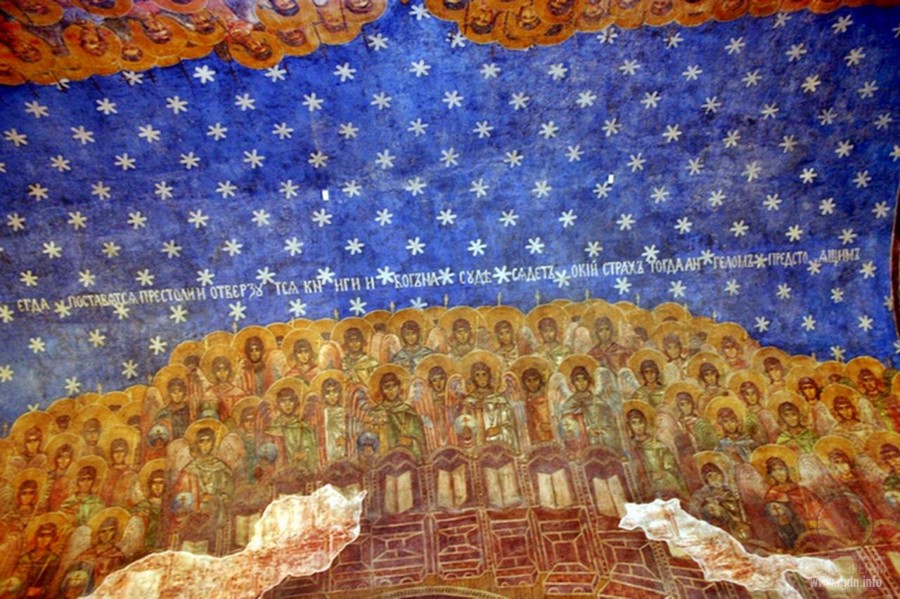
… The true faith is knowledge. Certainly, there are a lot of ways to God, but you can go round, winding along the pass repeatedly, or you can go straight. Thus, a direct way to God is the way through knowledge and Love…
… It is expressed through versatile cognition of the world in its various aspects: beginning from micro-life and up to macro-existence of space systems; in cognition of yourself both as a biological and spiritual structure and accordingly an essence of things around you. Certainly, it is impossible to learn everything, but you should aspire to do so. A human being should constantly grow in his or her knowledge, should develop his or her intellect, for the most valuable way is cognition of God through one’s mind when true knowledge, overcoming the animal nature, opens the gate of the subconscious by means of the key of Love. It is the eternal unshakable truth which has always existed in days of all highly developed human civilizations ever existing on the Earth. (Sensei of Shambala – Book I by A. Novykh)
On the opposite side there is a wall paining entitled The Angel Twisting the Heaven, which reminds a spiritual seeker of the fleetingness of time and the inevitable ruin of everything material. Moreover, this is a reminder of the primacy of the Spiritual World that creates the entire material world. At that, there automatically comes an understanding of the inevitability of God’s Judgement.
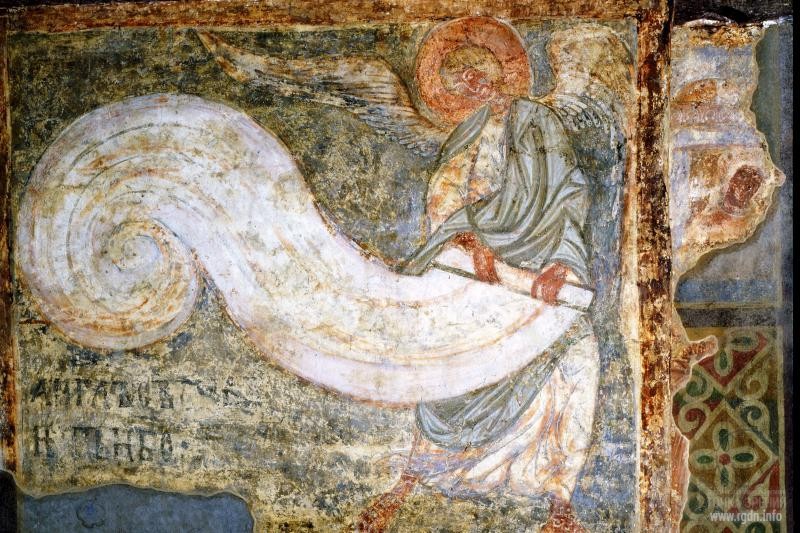
In view of this wall painting I involuntarily recall the words from the conversation with Igor Danilov in the aforesaid Unity program on AllatRa TV:
This is called the Last Era… (meaning our times)
As for the Holy Spirit, He lives just like everyone else, exists among us. He is truly here, and He is among us since recently… The last time is His function, so to say. We have referred to the fact that all prophets are gone. Muhammad was indeed the last one. There can be no more prophets, and the last chance remains for mankind. Hence, the Holy Spirit has to reside here, and He must watch what people will choose: that which we have discussed with you – the beautiful world, or what they currently have? And, using such economic terms, we either continue to develop this business or shut it down due to its unprofitability.
… Yes, there is another interesting thing. He (the Holy Spirit) will be hidden from you, that is, He will not shout about Himself in a loud voice. One who sees, who has spiritual eyes, does see Him, and one who has spiritual ears will hear Him. One who accepts Him knows who He is. He or she will see Him, recognise and come to Him, and just like Him will serve the Spiritual World. After all, the Holy Spirit is engaged in serving the Lord, because He is One in His greatness, right? He can serve nobody else. In the same way people must serve the Lord. At that, it is more fun to serve together, to jointly build the world of which we have dreamt, where people love and respect each other, where they live in peace and rejoice.
In conclusion of the article let me also share with you my personal understanding of the following questions. How many people in Christian traditions today remember of the primordial knowledge? What do parishioners and priests of various denominations divide? What do they prove, and whom do they prove this? Everyone argues about the number of flock, about whom to bow before and in which way, and how to invent more beautiful garments and more pompous rituals. Eh… People, people... What are we doing indeed!?! The eternal essence has been replaced with theatre…
But it’s in our hands to change everything! We have a unique chance… The pure primordial knowledge about the world and human being is now available without centuries-old beddings made by the human mind. We can accept this knowledge, become people worthy of the title of the Real Human, transform ourselves into a truly spiritual society, and establish a world where even the Holy Spirit would be pleased to stay.
By the way, the word “Chelovek” (“human being” in Russian) is far from being simple. “Chelo” originally meant “supreme”, and that is why in the old days the word indicated a forehead; whereas the word “vek” stands for “power”, and it originally meant “filled with power”, “eternal”. Hence, Chelovek (the Human) stands for the one who is filled with (full of) the supreme (spiritual) power. At that, the Real Human (Chelovek) or the Primordial Human is the filled one dominated by this supreme, eternal power – the Spiritual Nature. (AllatRa by A. Novykh)
P.S.: Accidents are not accidental…
Well, there were surely “unusual” events that traditionally take place when an interesting material is prepared and written.
After visiting St. Cyril’s Church I decided to surf the web and extend my awareness of what historians, archaeologists, religious ministers and other interested parties know about this place. I’ve got greatly amazed to discover there is quite little information about the church in fact, and it mostly remains within the historical monument concept. Then I decided to describe what I found on the church walls, in the light of the primordial knowledge given in the AllatRa book. Moreover, in order for every reader to form an opinion on the subject, I decided to collect as many photos as possible, which would vividly support the information presented in the article.
The first difficulty I faced was that there were very few photos on the whole internet, and even less of them were of decent quality. Continuing the search, I succeeded to find a professionally made 3D image gallery on St. Cyril’s Church. It used to . I was going to post it in the end of the article, but while I was writing it turned out the page had been removed from public access. As we can see again, accidents are not accidental. I decided to get in touch with the website administrators and clarify the reason why the gallery had become inaccessible on the web. Below is their answer which convinced me one more time, of how important St. Cyril’s Church was and how the System resisted dissemination of relevant knowledge. Let me quote: “Yes, the tour was on the web and was demonstrated to customers. However, since there was a refusal to pay for the agreed services, the tour has been removed from general access. Now we are waiting for a reaction and resolution of the administration (located in St. Sophia’s Cathedral territory).” Such wonders! At that, given the time I spent on the search of materials, I can say with confidence the aforesaid tour was of such a high quality that everyone from any part of the globe could see the entire beauty and essence of St. Cyril’s Church, sitting at home in front of their computers.
Below there are links to low-quality 3D images of St. Cyril’s Church. Unlike the image gallery which the management of St. Sophia of Kiev National Historical and Cultural Reserve has refused to pay for, these image galleries don’t make it possible to discern in detail everything that is described in this article. Nonetheless I am confident for those who crave for the Truth this won’t be an obstacle.
https://www.360cities.net/image/ukraine-kyiv-st-cyrils-church-3-kiev,
https://www.360cities.net/image/ukraine-kyiv-st-cyrils-church-kiev
Prepared by Vasily Gavrilov (Ukraine)
 St. Cyril’s Church in Kiev. Wall paintings
votes:
266
St. Cyril’s Church in Kiev. Wall paintings
votes:
266
|

Project Aim










Leave comment